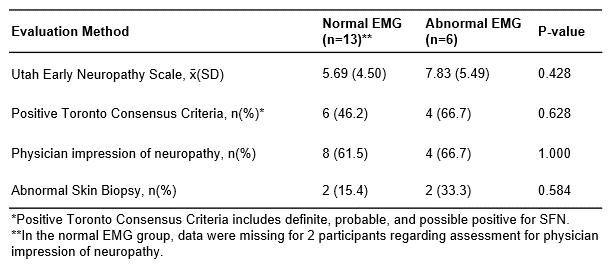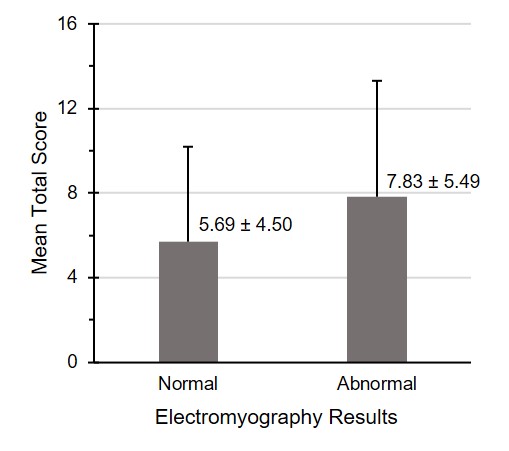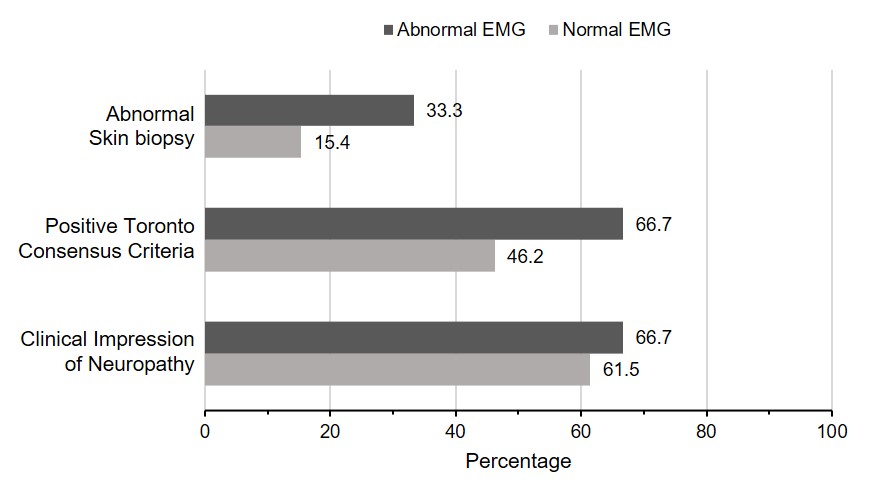Session Information
Session Type: Poster Session A
Session Time: 10:30AM-12:30PM
Background/Purpose: Small fiber neuropathy (SFN) is the most common peripheral nervous system manifestation of sarcoidosis. Diagnosis of SFN includes clinical evaluation, occasionally skin biopsy to evaluate intraepidermal nerve fiber density, and electrodiagnostic studies. The utility of these tests to aid in diagnosis of sarcoidosis-associated SFN is unclear. This study evaluates the yield of normal electromyography (EMG) in diagnosing SFN.
Methods: This is a cross-sectional study comparing 19 patients with biopsy-confirmed sarcoidosis with and without normal EMG. Participants were evaluated for SFN according to the Toronto Consensus Criteria (TCC) with possible, probable, or definite SFN; the Utah Early Neuropathy Scale (UENS) that captures both small and large sensory fiber function; physician impression of neuropathy (PIN); and skin biopsy.
Results: In total, 19 patients with age ranging 30-70 years were recruited, including thirteen participants with normal EMG and 6 participants with abnormal EMG. Of this cohort, 66.7% of participants with abnormal EMG had PIN compared to 61.5% of those with normal EMG (p=1.00). Those with normal EMG had a lower mean UENS score (M=5.69, SD=4.50) compared to those with abnormal EMG (M=7.83, SD=5.49, p=0.43). When evaluated by TCC, 46.2% with normal EMG tested positive for SFN compared to 66.7% of those with abnormal EMG (p =0.63). In addition, 15.4% with normal EMG had positive biopsy suggesting pure SFN compared to 33.3% (p=0.59).
Conclusion: Though this study aimed to correlate normal EMG data with clinically suspected SFN, surprisingly 4 of 12 participants with clinically suspected SFN had abnormal EMG and 2 of 7 participants without suspected SFN had incidental EMG abnormalities. Notably, those with alternative causes of neuropathy (e.g., diabetes) were excluded. Participants with an abnormal EMG were more likely to have a higher UENS score, consistent with impaired large fiber function. Skin biopsy suggesting small fiber dysfunction was present in some patients with normal EMG (likely pure small fiber neuropathy) and some with abnormal EMG (likely mixed neuropathy). Although these findings were not statistically significant, there are clinically significant correlates. Despite a small sample size, our findings suggest that EMG studies may not be an adequate screening instrument for sarcoidosis-associated polyneuropathy.
To cite this abstract in AMA style:
Caldwell K, Koppu S, Syed H, Syed A, Kron J, Iden T, Gwathmey K. The Use of Electromyography as a Screening Tool in Sarcoidosis-associated Neuropathy [abstract]. Arthritis Rheumatol. 2024; 76 (suppl 9). https://acrabstracts.org/abstract/the-use-of-electromyography-as-a-screening-tool-in-sarcoidosis-associated-neuropathy/. Accessed .« Back to ACR Convergence 2024
ACR Meeting Abstracts - https://acrabstracts.org/abstract/the-use-of-electromyography-as-a-screening-tool-in-sarcoidosis-associated-neuropathy/



